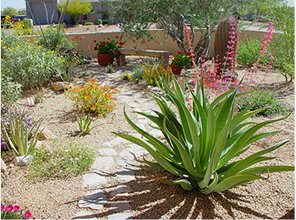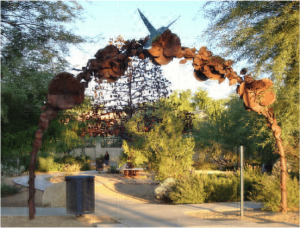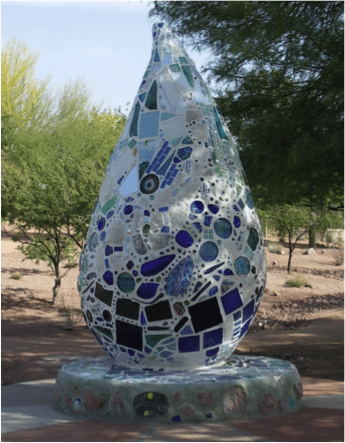Xeriscape (zer-i-scape) is a type of landscaping which uses water-wise plants and can even include small water features, patios, walkways, limited turf areas and effective mulches combined into an eye-appealing environment. Xeriscape should not look like a sea of gravel or barren rocks and cactus. Xeric gardens can be full of beautiful green plants that are water-efficient and able to withstand periods of drought. They are compatible with the environment of our Sonoran Desert, which has hot, dry summers and cool moist winters.

This garden was originally installed in 1987 and is located at the northwest corner of Erie Street and Arrowhead Drive. It showcases an assortment of shrubs, trees and other plants that thrive in Chandler’s desert climate. Displayed colorfully in the garden, they are identified by plaques containing each plant’s information. It’s the perfect place to begin your landscape plan.
A few years ago the garden underwent a major renovation. The Chandler Arts Commission provided a grant, allowing artist Juanita Hull-Carlson, to assist more than 115, 5th and 6th-grade Erie Elementary students in creating the bench and water drop sculpture artwork seen in the garden.
The garden is divided into themed areas where certain design ideas can be highlighted. Some of these themes include a children/pet friendly area, a wildlife garden and a low maintenance garden. A stabilized granite path has been installed which allows better access between areas of the garden. Signs are installed in each area explaining techniques or pointing out new design concepts and identifying plants by Latin and common name. The large trees offer shade and a seating area is included under the Palo Verde tree. Grading techniques highlight passive water harvesting through the installation of berms and swales.
Hummingbird Habitat
Nearly everyone enjoys watching hummingbirds – those tiny flyers with brilliant iridescent colors, incredibly fast wingbeats, and the ability to fly up, down, sideways, and backwards. In order to satisfy their energy demands, they spend their days collecting nectar from flowers and catching tiny insects, a necessary protein source.
Chandler’s Hummingbird Habitat was designed by Landscape Architect Dennis Peltz to demonstrate a low-maintenance landscape full of color, fragrance, interesting textures, coveted shade and features over fifty varieties of water-efficient plants that attract hummingbirds and butterflies. When you enter the habitat you are immediately surrounded by the beauty of native and desert adapted plants in a shady and inviting garden, including the subtle sound of falling water from a hidden water feature.

One of the first things visitors notice when entering the garden are two large iron sculptures by local artist Joe Tyler. One piece is an archway with a hummingbird collecting nectar from a flower and the other is a large tree that serves as a shade structure to the surrounding seating area. Plant materials were originally donated by local nurseries and were installed by boy scouts, girl scouts, Intel employees, Chandler Parks Department employees, Chandler residents, and special Olympic volunteers. Chandler High School art department students designed and constructed the ceramic tile artwork on the entry signage.
Established in 1999 from a water retention area in the back corner of Desert Breeze Park, the habitat is located at 600 North Desert Breeze Blvd. W. The habitat water feature provides a cooling effect as well as a drinking and bathing source for birds. Near the center of the garden is a large, artificial iron tree with a bench around its base providing a 360 degree opportunity to bird watch in the shade.
The Hummingbird Habitat is part of Desert Rivers Audubon’s Bird Habitat Recognition program and is lovingly maintained by their volunteers. No pesticides are applied in the Hummingbird Habitat as they could eliminate the birds’ food sources, including insects and seeds, impacting the health of the birds.
Both gardens are open to the public every day of the year. By walking the garden paths, you’ll see plants at their mature size, find examples of good plant combinations and discover ideas for your landscape.
Cathy Rymer is a Water Conservation Coordinator with the City of Chandler, one of fifteen Water – Use It Wisely partners to offer water saving advice and programs.


